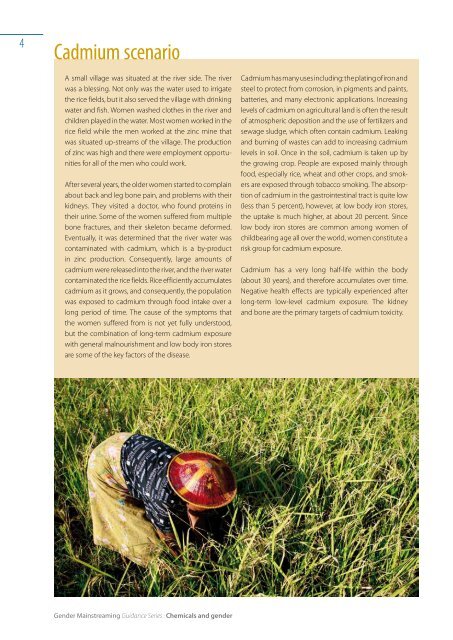Chemicals and gender
Chemicals and gender
Chemicals and gender
Create successful ePaper yourself
Turn your PDF publications into a flip-book with our unique Google optimized e-Paper software.
4<br />
Cadmium scenario<br />
A small village was situated at the river side. The river<br />
was a blessing. Not only was the water used to irrigate<br />
the rice fields, but it also served the village with drinking<br />
water <strong>and</strong> fish. Women washed clothes in the river <strong>and</strong><br />
children played in the water. Most women worked in the<br />
rice field while the men worked at the zinc mine that<br />
was situated up-streams of the village. The production<br />
of zinc was high <strong>and</strong> there were employment opportunities<br />
for all of the men who could work.<br />
After several years, the older women started to complain<br />
about back <strong>and</strong> leg bone pain, <strong>and</strong> problems with their<br />
kidneys. They visited a doctor, who found proteins in<br />
their urine. Some of the women suffered from multiple<br />
bone fractures, <strong>and</strong> their skeleton became deformed.<br />
Eventually, it was determined that the river water was<br />
contaminated with cadmium, which is a by-product<br />
in zinc production. Consequently, large amounts of<br />
cadmium were released into the river, <strong>and</strong> the river water<br />
contaminated the rice fields. Rice efficiently accumulates<br />
cadmium as it grows, <strong>and</strong> consequently, the population<br />
was exposed to cadmium through food intake over a<br />
long period of time. The cause of the symptoms that<br />
the women suffered from is not yet fully understood,<br />
but the combination of long-term cadmium exposure<br />
with general malnourishment <strong>and</strong> low body iron stores<br />
are some of the key factors of the disease.<br />
Gender Mainstreaming Guidance Series : <strong>Chemicals</strong> <strong>and</strong> <strong>gender</strong><br />
Cadmium has many uses including: the plating of iron <strong>and</strong><br />
steel to protect from corrosion, in pigments <strong>and</strong> paints,<br />
batteries, <strong>and</strong> many electronic applications. Increasing<br />
levels of cadmium on agricultural l<strong>and</strong> is often the result<br />
of atmospheric deposition <strong>and</strong> the use of fertilizers <strong>and</strong><br />
sewage sludge, which often contain cadmium. Leaking<br />
<strong>and</strong> burning of wastes can add to increasing cadmium<br />
levels in soil. Once in the soil, cadmium is taken up by<br />
the growing crop. People are exposed mainly through<br />
food, especially rice, wheat <strong>and</strong> other crops, <strong>and</strong> smokers<br />
are exposed through tobacco smoking. The absorption<br />
of cadmium in the gastrointestinal tract is quite low<br />
(less than 5 percent), however, at low body iron stores,<br />
the uptake is much higher, at about 20 percent. Since<br />
low body iron stores are common among women of<br />
childbearing age all over the world, women constitute a<br />
risk group for cadmium exposure.<br />
Cadmium has a very long half-life within the body<br />
(about 30 years), <strong>and</strong> therefore accumulates over time.<br />
Negative health effects are typically experienced after<br />
long-term low-level cadmium exposure. The kidney<br />
<strong>and</strong> bone are the primary targets of cadmium toxicity.


